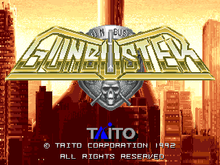| Gun Buster | |
|---|---|
 Title screen Title screen | |
| Developer(s) | Taito |
| Publisher(s) | |
| Designer(s) | T. Matsumoto Ryuji Tominaga |
| Programmer(s) | Shinji Soyano Hikaru Taniguchi Takashi Ishii |
| Artist(s) | Ryuji Tominaga Tsutomu Sekimoto Hisakazu Katoh |
| Composer(s) | Kazuyuki Ohnui Yasuko Yamada |
| Platform(s) | Arcade |
| Release |
|
| Genre(s) | First-person shooter |
| Mode(s) | Single-player, multiplayer (2-4 players) |
| Arcade system | Taito SZ System |
Gun Buster (ガン バスター), also known as Gunbuster (ガンバスター) and released in North America as Operation Gunbuster, is a first-person shooter video game developed by Taito and released for arcades in 1992. In contrast to on-rail light gun shooters at the time, this was one of the first arcade games to feature free-roaming FPS gameplay, the same year Wolfenstein 3D was released on personal computers.
Gun Buster's control scheme consists of a joystick for movement and strafing and a light gun for aiming and turning. The player can also carry multiple weapons, each with different recharge rates and movement speeds, and the game's maps include walls, glasses and columns that can be used for dodging and shootouts. It also features multiplayer deathmatch modes for up to four players, between two teams, on a dual-monitor arcade cabinet.
Gameplay
Gun Buster was produced by Taito in 1992. The game's control scheme consists of both a joystick and a light gun: the joystick moves the player character forwards, backwards and sidewards in a strafing maneuver, while the light gun moves the aiming reticule and turns the character around in clockwise and anti-clockwise directions, similar to later Wii Remote first-person shooters for the Wii home console. The player's arsenal consists of a primary machine gun and several secondary weapons: mines, laser, spark, and fire; each weapon has a different recharge rate and speed of movement. There is also an invincibility shield available that lasts for 15 seconds.
The mission mode can be played either as a single-player game, or a two-player cooperative game, with the second player able to join in at any time. The mission mode mostly consists of duels with bosses, across thirteen maps. In each map, the players runs through mazes trying to kill boss opponents before they kill the player. The maps include walls, glasses and columns that the player can use for dodging and shootouts.
As the first title to run on the Taito SZ System arcade system board, the game's graphics improved on Taito's previous light gun shooter Space Gun. The graphics were also more detailed and dynamic than other first-person shooters at the time, such as Wolfenstein 3D and Blake Stone; in Gun Buster's first level, for example, players can shoot out the windows in a glass elevator.
The game's competitive multiplayer mode features a head-to-head deathmatch between two teams, predating Doom's competitive multiplayer mode. It can be played either between two players, between four players with two players on each team, or between three players with two players on one team and a single player on the other team. The arcade cabinet features a dual-monitor setup, with the second screen used primarily in the deathmatch mode, for the second, third and/or fourth players.
Plot
| This article needs an improved plot summary. Please help improve the plot summary. (April 2015) (Learn how and when to remove this message) |
The game takes place in Agalia City, a science fiction city where cyborg crime has become rampant. In the year 2169, the city offered rewards for cyborg criminals and introduced an organization of hunters. As time passed, humanity began to refer to these hunters as "Gunbusters".
Reception
In Japan, Game Machine listed Gun Buster on their October 1, 1992 issue as being the sixth most successful upright/cockpit arcade cabinet of the month. On October 15, it was listed as the fifth top-grossing upright/cockpit arcade game of the month.
In 2005, Gamasutra surveyed game developers on their favorite arcade games of all time, with one developer, Ebon Kim, citing Gun Buster as his "favorite of all time" and writing a brief review, stating that he "would play for three hours straight without putting in another quarter" and it was "fun playing against other people". He believed "Gunbuster was a revolutionary first-person shooter game" and "before its time" and that if "an upgraded version was out today, many FPS enthusiasts would flock to it and tournaments would be held" or "at least that's what I wish would happen".
See also
- First person (video games)
- Star Cruiser (1988)
- The Super Spy (1990)
References
- "Operation Gunbuster". Play Meter. Vol. 18, no. 10. September 1992. p. 7.
- "Operation Gunbuster". RePlay. Vol. 17, no. 12. September 1992. p. 5.
- ^ "Gunbuster [coin-op] Arcade Video game, Taito Corp. (1992)". Arcade-history.com. 2013-01-27. Retrieved 2015-04-07.
- ^ "Gun Buster - Videogame by Taito". Arcade-museum.com. Retrieved 2015-04-07.
- ^ "The Arcade Flyer Archive - Video Game Flyers: Operation Gunbuster, Taito". Flyers.arcade-museum.com. 2008-02-01. Retrieved 2015-04-07.
- ^ "Looking At Taitos History As They Turn 60". Arcade Heroes. August 2013. Retrieved 2014-01-09.
- ^ "The Brief Life of Arcade First Person Shooting Games". Arcade Heroes. June 2013. Retrieved 2014-01-10.
- ^ "Question of the Week Responses: Coin-Op Favorites". Gamasutra. August 2005. Retrieved 2014-01-09.
- "Gun Buster - Videogame by Taito".
- "Game Machine's Best Hit Games 25 - アップライト, コックピット型TVゲーム機 (Upright/Cockpit Videos)". Game Machine (in Japanese). No. 435. Amusement Press, Inc. 1 October 1992. p. 33.
- "Game Machine's Best Hit Games 25 - アップライト, コックピット型TVゲーム機 (Upright/Cockpit Videos)" (PDF). Game Machine (in Japanese). No. 436. Amusement Press, Inc. 15 October 1992. p. 29.
External links
- Gun Buster at the Killer List of Videogames
- Gunbuster at the Arcade History database